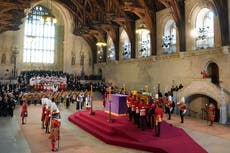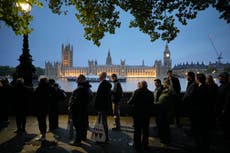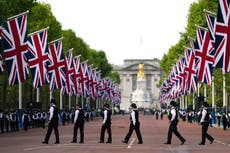The view from the media gazebo: What it’s like to cover the death of the Queen
I was unprepared for the strength of feeling during that first 24 hours. Covering the story is all-consuming. Participating in it, even more so

Your support helps us to tell the story
From reproductive rights to climate change to Big Tech, The Independent is on the ground when the story is developing. Whether it's investigating the financials of Elon Musk's pro-Trump PAC or producing our latest documentary, 'The A Word', which shines a light on the American women fighting for reproductive rights, we know how important it is to parse out the facts from the messaging.
At such a critical moment in US history, we need reporters on the ground. Your donation allows us to keep sending journalists to speak to both sides of the story.
The Independent is trusted by Americans across the entire political spectrum. And unlike many other quality news outlets, we choose not to lock Americans out of our reporting and analysis with paywalls. We believe quality journalism should be available to everyone, paid for by those who can afford it.
Your support makes all the difference.Just over a week ago (though if that feels like another era, it was) a colleague held a leaving do at the Yorkshire Grey pub in Farringdon. I was about to leave when I was shown a text that sent me into a panic.
It suggested the Queen was close to the end of her life, and we’d better get ready for one of the biggest news stories in living memory.
My first thought was whether I could lay my hands on the laminated crib-sheets that were set aside for this eventuality. Having established their whereabouts, I went home, safe in the knowledge that most previous tip-offs about Operation London Bridge had proved premature.
The next morning, Thursday, as we all got our heads round the new prime minister’s energy policy, it very soon became apparent that one of the biggest economic interventions in peacetime Britain would only form part of our news bulletin that night.
The ominous statement from Buckingham Palace that the Queen was under “medical supervision” prompted an immediate change to the Channel 4 News running order – and a wardrobe change too, from a bright fuchsia to a sober navy.
A few hours later, even that seemed too optimistic and I swapped to a black blouse. A black tie was sent down to correspondent Matt Frei, who’d diverted to Buckingham Palace.
And then, at 6.31pm, came the words we were all prepared for, and yet the enormity of the moment still took us by surprise. “Buckingham Palace has announced the death of Queen Elizabeth II.” The veteran BBC presenter Huw Edwards apparently rehearsed the statement in front of his bathroom mirror. His delivery was word perfect.
At Channel 4, we’d practised too, of course, substituting the Queen’s real name for “Mrs Robinson”, lest anyone stumbling across the rehearsal raised a false alarm. But only as I heard the countdown in my ear did “Mrs Robinson’s” death become shockingly real.
Our correspondent Andy Davies found people in tears at Windsor Castle, stunned that someone who’d been with them all their lives had, as Edwards memorably put it, “left us”. Their upset brought tears to my eyes too. Grief is infectious after all.
At the end of my Times Radio show the next day, the national anthem played after Charles III’s inaugural King’s Speech. My co-presenter Michael Portillo had come into the studio ready for his programme, and as soon as the anthem began, he stood respectfully. I got to my feet too, and sang heartily, replacing Queen for King for the first time.
I was unprepared for the strength of feeling during that first 24 hours. Covering the story is all-consuming. Participating in it, even more so. Personally, I have a low tolerance for the national pastime of queueing, so I marvel at the hundreds of thousands lining the embankment, bound for Westminster Hall, or the thousands who filed past Buckingham Palace at the beginning of the week, their flowers tidily arranged in mini mountains of mourning around Green Park. The tidiness is the visible representation of years of invisible work by officials.
To enable media from across the world to cover the story, a gazebo tent city has sprung up behind the Palace. Rows of portaloos, a myriad of lanyards and coloured wristbands. Today’s wristband is plastic – an upgrade on yesterday’s paper one. Our planning supremo Stuart McTeer informs us what shade of bracelet is required in his invaluable morning email.
To keep up to speed with all the latest opinions and comment, sign up to our free weekly Voices Dispatches newsletter by clicking here
Some of our viewers wish this wasn’t the only story in town. And certainly we made sure we gave airtime to the global reaction to the royal death, anti-monarchy protests, not to mention crucial developments in Ukraine and the cost of living crisis. I look forward to scrutinising Liz Truss’ “fiscal event” too.
Standing under our Channel 4 News gazebo as the Queen’s coffin returned to Buckingham Palace on Tuesday night, I felt sure I wouldn’t be one of those people intent on capturing a fleeting moment of history on their mobile phones. But – like the narrator of Philip Larkin’s Church Going, who’s not usually devout, but nevertheless takes off his cycle-clips in “awkward reverence” when he happens upon a church – I too found myself snatching a video.
As the hearse glided through the palace gates, a colleague burst into tears.
It was the constitutional historian Walter Bagehot who warned not to “let in daylight upon magic”. Of course, a new day will dawn, but for now, the thousands queuing and the millions watching on TV are entranced.
Cathy Newman is presenter and investigations editor at Channel 4 News




Join our commenting forum
Join thought-provoking conversations, follow other Independent readers and see their replies
Comments